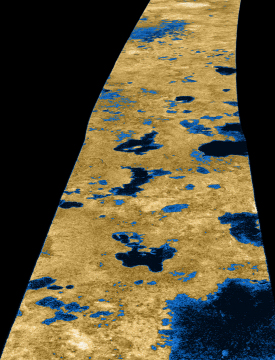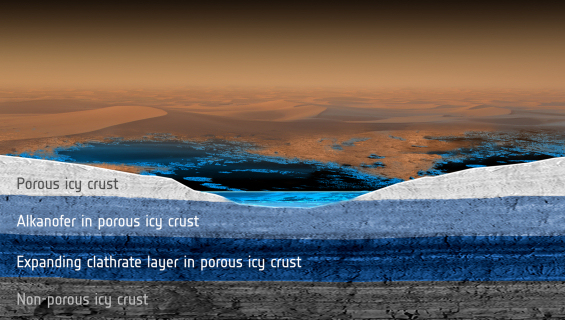Titan's subsurface reservoirs modify methane rainfall
1 September 2014
The international Cassini mission has revealed hundreds of lakes and seas spread across the icy surface of Saturn's moon Titan, mostly in its polar regions. These lakes are filled not with water but with hydrocarbons, a form of organic compound that is also found naturally on Earth and includes methane. While most of the liquid in the lakes is thought to be replenished by rainfall from clouds in the moon's atmosphere, the cycling of liquid throughout Titan's crust and atmosphere is still not well understood.A recent study led by Olivier Mousis at the Université de Franche-Comté, France, and involving colleagues at Cornell University and NASA's Jet Propulsion Laboratory in the USA, probed the hydrological cycle of Titan by examining how Titan's methane rainfall would interact with icy materials within underground reservoirs. They found that the formation of materials called clathrates changes the chemical composition of the rainfall runoff that fills these hydrocarbon reservoirs, leading to the formation of reservoirs of propane and ethane that may feed into some rivers and lakes.
"We knew that a significant fraction of the lakes on Titan's surface might be connected with hidden bodies of liquid beneath Titan's crust, but we just didn't know how they would interact", says Mousis. "Now, we've modelled the moon's interior in great detail, and have a better idea of what these hidden lakes or oceans could be like."
Mousis and colleagues modelled how a subsurface reservoir of liquid hydrocarbons would diffuse throughout Titan's porous icy crust. They found that this diffusion could cause a new reservoir – formed from clathrates - to form where the bottom of the original reservoir meets layers of non-porous ice.
Clathrates are compounds in which water forms a crystal structure with small cages that trap other substances like methane and ethane. On Earth, clathrates that contain methane are found in some polar and ocean sediments. On Titan, the surface pressure and temperature allow clathrates to form when liquid hydrocarbons come into contact with water ice, a main component of the moon's crust. These clathrates could remain stable as far down as several kilometres below the surface of Titan.
 |
| Lakes on Titan. Credit: NASA/JPL/USGS |
"One of the interesting properties of clathrates is that they cause fractionation – in this case, they trap and split molecules into a mix of liquid and solid phases," adds Mousis. Because of this, astronomers have suggested that clathrates may be responsible for many unusual phenomena on Titan, including the depletion of the heavy noble gases in the moon's atmosphere, and variations in the moon's polar radius.
Titan's subsurface clathrate reservoirs would interact with and fractionate the liquid methane within the original underground hydrocarbon lake, slowly changing its composition. Eventually, subsurface lakes that had come into contact with the clathrate layer would mainly be composed of either propane or ethane, depending on the type of clathrate that had formed.
Importantly, this would continue up to Titan's surface. Lakes fed by these propane or ethane subsurface reservoirs would show the same kind of composition, whereas those fed by rainfall would be different and contain methane, nitrogen, and trace amounts of argon and carbon monoxide. "This means we would be able to look at the composition of the surface lakes and learn something about what is happening deep underground," says Mousis.
The Cassini Solstice mission, an extension of Cassini that runs until 2017, will give scientists a chance to explore Titan's surface lakes even more closely by performing an additional 54 close flybys of the Saturnian moon.
"Understanding Titan's hydrological cycle is one of the most important objectives of Cassini's extended mission," says ESA's Cassini-Huygens project scientist Nicolas Altobelli. "The changing seasons on Titan mean that soon we can again explore the lake-filled region at its north pole, and maybe spot seasonal phenomena we haven't seen before. This is crucial to getting a better understanding of what lies hidden beneath Titan's surface."
More information
"Equilibrium composition between liquid and clathrate reservoirs on Titan" by O. Mousis et al. is published in the journal Icarus, Volume 239, 1 September 2014; doi: 10.1016/j.icarus.2014.05.032
The results are reported by Olivier Mousis, Université de Franche-Comté, France; Mathieu Choukroun and Christophe Sotin, Jet Propulsion Laboratory, USA; and Jonathan I. Lunine, Center for Radiophysics and Space Research, Cornell University, USA.
The Cassini–Huygens mission is a cooperative project of NASA, ESA and the Italian Space Agency (ASI). Launched in 1997, Cassini arrived in the Saturn system in 2004 and is studying the ringed planet and its moons. The Huygens probe was released from the main spacecraft and, in 2005, parachuted through the atmosphere to the surface of Saturn's largest moon, Titan.
NASA's Jet Propulsion Laboratory, a division of the California Institute of Technology in Pasadena, manages the mission for NASA's Science Mission Directorate, Washington, D.C.
Contacts
Olivier Mousis
Université de Franche-Comté, France
Phone: +33-381-666-921
Mob: +33 660 853 392
Email: olivier![]() obs-besancon.fr
obs-besancon.fr
Nicolas Altobelli
ESA Cassini-Huygens Project Scientist
Directorate of Science and Robotic Exploration
European Space Agency
Phone: +34-91-813-1201
Email: nicolas.altobelli![]() sciops.esa.int
sciops.esa.int




